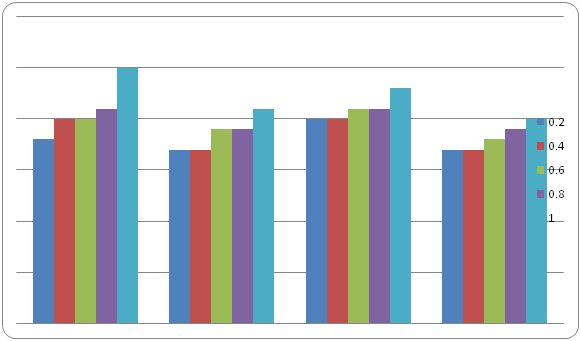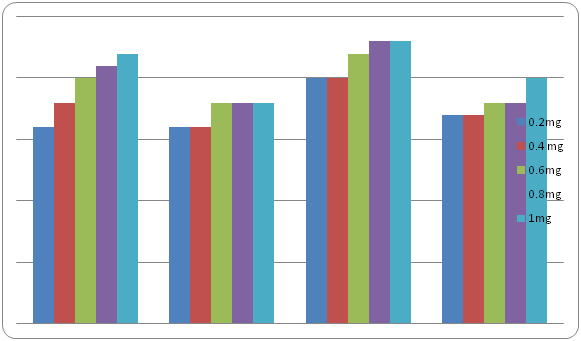MOJ
eISSN: 2641-9297


Research Article Volume 1 Issue 6
Department of Industrial Biotechnology, Shri Andal Alagar College of Engineering, India
Correspondence: Yasodha T, Department of Industrial Biotechnology, Shri Andal Alagar College of Engineering, Kancheepuram, Tamilnadu, India, Tel 044 2756 5662
Received: October 31, 2018 | Published: December 26, 2018
Citation: Yasodha T, Jeevitha, Yogesh, et al. Efficiency of phytobiotics of Indian medicinal plant Tridax procumbens L. against wound infecting bacteria. MOJ Research Review. 2018;1(6):278-280 DOI: 10.15406/mojcrr.2018.01.00046
Many pathogenic bacteria are becoming increasingly resistant to many commonly used antibiotics including penicillins, macrolides and aminoglycosides.Hence in the present study efficacy of phytobiotics of Tridax procumbens (Linn) was assessed against the Escherichia coli, Staphylococcus aureus Streptococcus pyogens and Pseudomonas aeruginosa cultured from wound swab samples of 50 patients of diverse types of wounds. The crude extract of leaves of Tridax procumbens L. was used and compared with cephalosporin, amoxicillin and streptomycin as control. The results of antibacterial resistant profile of Tridax procumbens L. showed that there is an increase in the efficacy up to 16-24% for E.coli ; 9-18% for Streptococcus pyogens and 15-30% for Pseudomonas aeruginosa. The results are on par with all selected antibiotics for Staphylococcus aureus. Hence it is recommended that an alternative to antibiotics are the phytobiotics of Tridax procumbens (Linn) for the rapid healing of wounds.
Keywords: phytobiotics, Tridax procumbens L., leaf extract, wound infection bacteria
Widespread antibiotic usage exerts a selective pressure that acts as a driving force in the development of antibiotic resistance. The association between increased rates of antimicrobial use and resistance has been documented for nosocomial infections as well as for resistant community acquired infections.1,2 As resistance develops to "first-line" antibiotics, therapy with new, broader spectrum, more expensive antibiotics increases, but is followed by development of resistance to the new class of drugs.3 An alternative to antibiotics are the phytobiotics which can be used as potential resource in the treatment of infected wounds. Tridax procumbens Linn (Tridax) is commonly known as coat buttons’ in English because of the appearance of its flowers and in Tamil Vettukkaaya thalai. It has been extensively used in ayurvedic system of medicine. It is a wild herb distributed throughout India. The leaf extract possesses antiseptic, insecticidal and anti parasitic properties. It is also used to check haemorrhage from cuts, bruises and wounds.The use of plants and plant bioactive compounds dates back thousands of years to the ancient Egyptians, Chinese, Indians and Greeks.4,5 Indian herbal medicines have been used for many centuries for treating various human diseases.4,6–8
Herbal medicines are well known for its fast remedy and cheap source of availability. Several Indian medicinal weeds are popular for its medicinal value in healing wounds and treating other ailments. Recent studies also impart the identification and isolation of new therapeutic compounds of medicinal importance from the higher plants for specific diseases. Natural products from higher plants may contribute to the search for new drugs by indicating new modes of pharmacological action. Hence the present study is focused to determine the pharmacological role of leaf extracts of Tridax procumbens against the wound infecting bacteria such as E.coli, Staphylococcus aureus, Streptococcus pyogens and Pseudomonas aeruginosa. Phytobiotic resistance profile was compared with cephalosporin, amoxicillin and streptomycin.
The leaves of Tridax procumbens (Linn) collected from various areas of Namakkal District were crushed and extract was taken in sterilized petri dishes. Air dried crude extract powder of Tridax biotics was taken in different concentrations of 0.2, 0.4, 0.6, 0.8 and 1mg for the study. The antibacterial activity of the extracts was analyzed and compared with the standard antibiotics Cephalosporin, Streptomycin and Amoxicillin.
Collection of microbes
Bacterial strains such as Escherichia coli, Streptococcus pyogens Pesudomonas aeruginosa, Staphylococcus aureus were isolated from diverse wounds of 50 patients which were collected on cotton swabs. The isolated microbes were maintained in Nutrient agar Broth and cultured in Nutrient Agar medium.
Preparation of medium and inoculum
Nutrient agar medium was prepared by dissolving 2.8g of nutrient agar in 100ml of distilled water. The solution was sterilized in an autoclave at 121°C for 15min. It was cooled and poured into sterile Petri dishes to solidify. Each wound infecting bacterium is inoculated on agar by streaking with the swab containing inoculums. Rotate the plate by 600 and repeat the rubbing procedure. This will ensure an even distribution of the inoculums.
Disc diffusion method
Antibiotic discs were kept on the surface of the inoculated plates. The Tridax biotic disc was prepared by dipping the 6mm Whatman No1 Filter paper in the 0.2, 0.4, 0.6, 0.8 and 1mg aqua extract of Tridax. Phytobiotic discs were kept in the incubator for complete drying. Maximum of 5 discs were kept in the petriplate.
Results for concentrations 0.2, 0.4, 0.6, 0.8 and 1mg Tridax biotics and the same concentrations of standard antibiotics act on wound infecting bacteria were recorded with reference to the zone of inhibition in cm. (Table 1 & Figures 1−4). The result was found to be most effective against all tested microorganisms. Maximum inhibition concentration of phytobiotics is 0.8 to 1mg which is effective against all wound infecting bacteria (Figure 1-4). The results pertaining to the antibiotic activity of Tridax procumbens Linn (leaf extract) against the wound infecting pathogen Staphylococcus aureus is on par with the selected antibiotics. The infected wounds containing bacterial pathogens such as, Staphylococcus aureus, Streptococcus pyogens, Pesudomonas aeruginosa and Escherichia coli were treated with phytobiotics of Tridax showed the maximum zone of inhibition (ZOI) as follows 2.1>2.2>2.3>2.5(cm) Escherichia coli was controlled by the antibiotics from the range 1.9 to 2.1cm as maximum zone of inhibition, where as the concentration of 0.4mg phytobiotics of Tridax showed maximum zone of inhibition up to 2.5cm. Next to Escherichia coli, Pesudomonas aeruginosa was controlled maximum by Tridax biotics .This was confirmed in terms of 2.3cm zone of inhibition. The maximum zone of inhibition for Staphylococcus aureus and Streptococcus pyogens was 2.1cm and 2.2cm respectively. Similar kind of experimental results of, 9–11 showed the efficacy of bioactive compounds of various herbal medicinal plants against infectious pathogens.
Antibiotics & phytobiotics |
E.coli |
Staphylococcus aureus |
Streptococcus pyogens |
Pseudomonas aeruginosa |
Cephalosporin |
2.1 |
1.9 |
1.8 |
1.8 |
Streptomycin |
2 |
2.1 |
2.3 |
2 |
Amoxicillin |
1.9 |
2 |
2 |
2.1 |
Tridax biotics |
2.5 |
2.1 |
2.2 |
2.3 |
Table 1 Effect of Tridax procumbens against wound infection bacteria (Diameter of inhibition zone in cm)
*Results are expressed as the mean value of triplicates.

Figure 1 Antibiotic and Tridax biotics resistance Profile for E.coli (concentration in mg Vs zone of inhibition in cm).

Figure 2 Antibiotic and Tridax biotic resistance Profile for S.pyogens (concentration in mg Vs zone of inhibition in cm).
The response of wound infection pathogenic bacteria for the Tridax biotics are in the following order:
Staphylococcus aureus>Streptococcus pyogens >Pesudomonas aeruginosa > Escherichia coli
From the present investigation of resistance profile of wound infection causing bacteria, it is suggested that usage of antibiotics could be reduced by the proper dosage of phytobiotics . Hence the Tridax biotics can be used as potential resource in the treatment of infected wounds.12,13
None.
The authors declare that there is no conflict of interest.

©2018 Yasodha, et al. This is an open access article distributed under the terms of the, which permits unrestricted use, distribution, and build upon your work non-commercially.